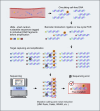Improvement of the sensitivity of circulating tumor DNA-based liquid biopsy: current approaches and future perspectives
- PMID: 40787067
- PMCID: PMC12332530
- DOI: 10.37349/etat.2025.1002333
Improvement of the sensitivity of circulating tumor DNA-based liquid biopsy: current approaches and future perspectives
Abstract
Liquid biopsy (LB) is a complex of procedures aimed at the detection of tumor-derived fragments (nucleic acids, proteins, cells, etc.) persisting in the blood or other body fluids. It can be utilized for early cancer diagnosis, analysis of biomarkers of tumor drug sensitivity and prognosis, monitoring of minimal residual disease (MRD), etc. Circulating tumor DNA (ctDNA) is an accessible and reliable LB analyte as it may contain tumor-specific mutations and is amenable to efficient detection by next-generation sequencing (NGS) or droplet digital PCR (ddPCR). High level of ctDNA is typically associated with increased tumor burden and poor prognosis, whereas treatment-related ctDNA clearance increases the probability of a favorable disease outcome. Major efforts have been invested in enhancing the analytical performance of ctDNA detection. Stimulation of apoptosis of tumor cells by irradiation of cancer lumps has been shown to result in a transient but modest increase in ctDNA concentration. There are several sophisticated modifications of ultra-deep NGS protocols, which discriminate between "true" low-copy mutation-specific signals and sequencing artifacts. Slowing physiological ctDNA decay by interfering with liver macrophages and circulating nucleases has shown promise in animal experiments. Reproducibility of ctDNA-based LB assays remains insufficient for samples with ultra-low content of ctDNA; hence, interlaboratory harmonization of ctDNA testing procedures is of paramount importance.
Keywords: Liquid biopsy; analytical performance; cancer therapy; circulating tumor DNA; circulating tumor DNA assays; next-generation sequencing; reproducibility.
© The Author(s) 2025.
Conflict of interest statement
Evgeny N. Imyanitov who is the Editorial Board Member of Exploration of Targeted Anti-tumor Therapy had no involvement in the decision-making or the review process of this manuscript. The other authors declare that they have no conflicts of interest.
Figures



Similar articles
-
Can a Liquid Biopsy Detect Circulating Tumor DNA With Low-passage Whole-genome Sequencing in Patients With a Sarcoma? A Pilot Evaluation.Clin Orthop Relat Res. 2025 Jan 1;483(1):39-48. doi: 10.1097/CORR.0000000000003161. Epub 2024 Jun 21. Clin Orthop Relat Res. 2025. PMID: 38905450
-
Recent advances in liquid biopsy for precision oncology: emerging biomarkers and clinical applications in lung cancer.Future Oncol. 2025 Aug 5:1-19. doi: 10.1080/14796694.2025.2542051. Online ahead of print. Future Oncol. 2025. PMID: 40762271 Review.
-
Detection, quantitation, and genotyping of human papillomavirus circulating tumor DNA by droplet digital PCR.J Clin Microbiol. 2025 Aug 19:e0058525. doi: 10.1128/jcm.00585-25. Online ahead of print. J Clin Microbiol. 2025. PMID: 40827899
-
The Black Book of Psychotropic Dosing and Monitoring.Psychopharmacol Bull. 2024 Jul 8;54(3):8-59. Psychopharmacol Bull. 2024. PMID: 38993656 Free PMC article. Review.
-
Management of urinary stones by experts in stone disease (ESD 2025).Arch Ital Urol Androl. 2025 Jun 30;97(2):14085. doi: 10.4081/aiua.2025.14085. Epub 2025 Jun 30. Arch Ital Urol Androl. 2025. PMID: 40583613 Review.
References
Publication types
LinkOut - more resources
Full Text Sources
